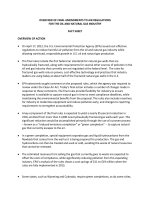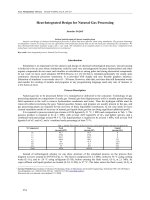natural gas production engineering
Bạn đang xem bản rút gọn của tài liệu. Xem và tải ngay bản đầy đủ của tài liệu tại đây (20.59 MB, 537 trang )
PREFACE
This book presents a comprehensive and rigorous treatment of the technology
of
producing and transporting natural gas. The design of a development plan for a
natural gas field always depends
on
the reservoir and well characteristics, tubing
and flowline performance, and compressor and processing equipment character-
istics. This text emphasizes a systems approach to natural
gas
production, since
change in each component will affect the performance of theother components.
Most of
us
who teach others have heard the adage that the best
way
to learn a
subject in depth
is
to
teach it. As a case in point, Natural Gas Production
Engineering is a historyofmany years ofsuccessfully using the material for natural
gas engineering courses at The University of Tulsa, The Pennsylvania State
University, and adult education courses in the United States and overseas. This
book
is
arranged so that it can be used as a text orreferencework for studentsand
practicing engineers, geologists, and managers in the crude oil and natural gas
production industry.
Chapters 1 to 3 serve as an introduction to the subject. Chapter 1 traces the
development of the natural gas industry and tries to instill
in
the reader an
awareness of theincreased role natural gas will playasasource
of
energy. Chapter
2 reviews the properties of natural gases and condensate systems that are of
importance in solving gas
well
performance, gas production, and gas transmission
problems. Chapter 3 discusses some concepts of thermodynamics that
are
used
throughout the book.
Chapters 4 through 8 focus on separation and processing, compression,
measurement, and flow
of
gas in pipelines, tubings and annuli. Multiphase flow in
pipes
is
treated and procedures for the design and selection of surface equipment
are clearly outlined. Methods for determining static and flowing bottom-hole
pressures from wellhead data are presented for both shallow wells and very deep
wells producing sour gas. The problem of liquid loading
in
gas wells
is
also
addressed.
Much of the material
on
which this book
is
based
was
drawn from the
publications
of
the Society of Petroleum Engineers
of
the American Institute
of
Mining, Metallurgical and Petroleum Engineers, the American Gas Association,
the Division of Production of the American Petroleum Institute, the Gas
Proces-
sors Suppliers Association, the Petroleum Extension Service
of
the University of
Texas at Austin, and the Gas Conditioning Conference of the University
of









